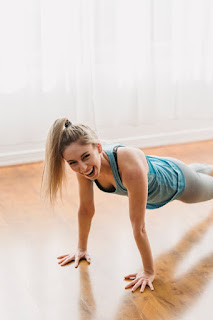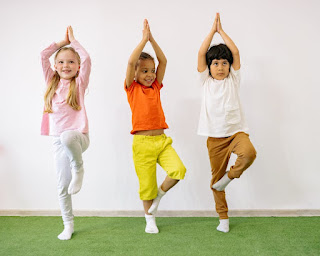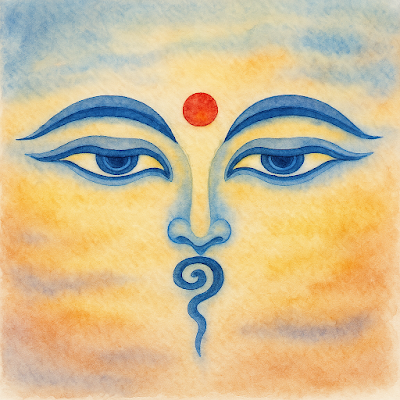Deeping Your Yoga Practice: Intermediate Techniques
Yoga is a journey of continuous exploration and growth, not just a physical practice but a profound experience that nurtures the mind, body, and spirit. As you embark on this journey, transitioning from a beginner to an intermediate yogi is a pivotal moment that opens up new horizons of possibilities and challenges. “Deepening Your Yoga Practice: Intermediate Techniques” is designed to guide you through this transformative phase, helping you to explore new depths in your practice and discover your full potential.
Whether you’re noticing signs of readiness for more advanced poses, curious about exploring new styles like Kundalini or Ashtanga, seeking to master complex breathing techniques, aiming to perfect your alignment and form, or considering to elevate your practice through workshops and retreats, this article is your roadmap to advancing your yoga journey. Each step forward is an opportunity to deepen your connection with yoga, enhancing not only your physical well-being but also your mental and emotional balance. Embrace this journey with an open heart and mind, and let the transformative power of yoga lead you to new heights of inner peace and fulfillment.
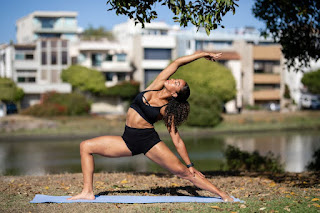
Progressing from Beginner to Intermediate:
Signs You’re Ready
Embarking on the journey from a beginner to an intermediate yoga practitioner is like sailing from the calm shores into the open sea, where the waters invite depth and discovery. This transition is not marked by the mere passage of time, nor solely by the mastery of certain poses. Instead, it’s a subtle, yet profound, evolution in your practice, your body’s awareness, and your spiritual journey. As you stand on this precipice, ready to dive deeper, several signs indicate your readiness to embrace the intermediate yoga realm.
Your breath becomes your most intimate guide, flowing through each pose with greater awareness and intention. You start to notice the subtle ways in which your breath supports your movements, deepening your connection to the present moment and enhancing your practice from within. Increased Physical Strength and Flexibility As your body adapts to the practice, poses that once seemed unattainable become accessible. You find a new edge in your flexibility and strength, enabling you to explore asanas with more depth and stability. This physical transformation is a testament to your dedication and a sign of readiness to challenge yourself further.
Your awareness of your body’s alignment and positioning in space becomes more nuanced. This acute sense of proprioception allows you to make micro-adjustments in your poses, optimizing the flow of energy and reducing the risk of injury. It’s a dance of balance and grace, where each movement is mindful and intentional.
A natural curiosity blossoms within you, a yearning to explore beyond the familiar. You’re drawn to the layers of yoga that intertwine breath, movement, and meditation in more complex ways. This thirst for knowledge and experience signals your readiness to delve into advanced techniques and philosophies. The Emergence of a Personal Practice Perhaps the most telling sign is the emergence of a personal practice. Beyond guided classes, you find solace and strength in practicing alone, listening deeply to your body’s needs and your heart’s desires. This self-guided practice is a beautiful affirmation of your growth and readiness to explore intermediate techniques.
As you recognize these signs within yourself, embrace them with a heart full of gratitude and curiosity. The journey into intermediate yoga is not just about advancing in practice but deepening the connection with your inner self, exploring the vast expanse of your potential, and flowing with the rhythm of your breath. Welcome to this new chapter, where each pose is a discovery, and every breath is a step deeper into the essence of yoga.
A Deepening Connection with Your Breath
Heightened Body Awareness and Alignment
Pranayama and Beyond Breath is the essence of life and a cornerstone of yoga practice. As you transition from beginner to intermediate and beyond, exploring advanced breathing techniques, or Pranayama, becomes a powerful tool for enhancing your practice, improving health, and deepening your spiritual connection. Pranayama exercises extend beyond simple inhalation and exhalation, involving specific patterns that influence the flow of energy in the body, leading to profound physical, mental, and emotional benefits.
The Victorious Breath Ujjayi Pranayama, often practiced in Ashtanga and Vinyasa yoga, is known for its soothing, oceanic sound, created by constricting the back of the throat. It promotes concentration and endurance, regulates blood pressure, and increases the flow of oxygen. To Practice Ujjayi: Begin in a comfortable seated position. Inhale deeply through the nose, then exhale slowly through a slightly constricted throat, making a soft hissing sound. Continue this breathing pattern, focusing on the sound and sensation of your breath.
The Skull Shining Breath Kapalabhati is a stimulating breath that cleanses the lungs and sinuses, invigorates the brain, and enhances digestive function. It involves short, powerful exhales and passive inhales. To Practice Kapalabhati: Sit comfortably with your spine straight. Take a deep breath in, then exhale forcefully through your nose, pulling your navel towards your spine. Let your inhalation be automatic, focusing on the exhale. Start with 20 repetitions and gradually increase.
Alternate Nostril Breathing Anulom Vilom balances the body’s energy channels, calms the mind, and improves focus. It involves inhaling through one nostril, holding the breath, and exhaling through the opposite nostril. To Practice Anulom Vilom: Sit in a comfortable position with your back straight. Close your right nostril with your thumb, inhale through the left nostril. Close the left nostril with your fingers, open the right nostril, and exhale. Inhale through the right nostril, then close it, open the left, and exhale. Continue this pattern for 5 to 10 minutes.
The Bee Breath Bhramari Pranayama is known for its immediate calming effect on the mind. It involves making a humming sound during exhalation, resembling the sound of a bee. To Practice Bhramari: Sit comfortably, eyes closed, and relax your face. Close your ears with your thumbs, place your fingers over your eyes. Inhale deeply, then exhale slowly making a humming sound. Repeat 5 to 10 times.
Integrating Pranayama into Your Practice Incorporating these Pranayama techniques into your daily practice can transform your yoga journey, offering tools for managing stress, enhancing concentration, and promoting a deeper sense of inner peace. Begin with a few minutes each day, gradually extending your practice as you become more comfortable with the techniques. Remember, the journey of yoga is personal and unique to each individual. Explore these breathing techniques with mindfulness and patience, and observe the profound impacts they can have on your practice and your life.
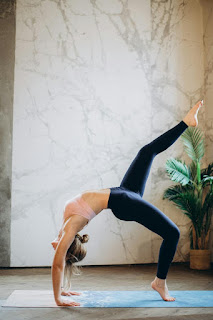
Deep Dive into Yoga Styles:
Vinyasa Yoga:
Iyengar Yoga:
Vinyasa, Iyengar, Kundalini, and Ashtanga Embarking on the exploration of yoga styles like Vinyasa, Iyengar, Kundalini, and Ashtanga can profoundly enrich your practice, offering varied paths to physical health, mental clarity, and spiritual growth. Understanding the essence of each style and how to weave them into your practice can open new dimensions of yoga that resonate with your personal needs and aspirations.
The Flow of Movement and Breath Vinyasa Yoga is characterized by its fluid, almost dance-like sequences, where movements are synchronously aligned with the breath. This style emphasizes the transition between poses as much as the poses themselves, creating a dynamic meditation in motion. How to Implement and Improve Your Vinyasa Practice:
Focus on Breath: The essence of Vinyasa is the harmonious connection between breath and movement. Concentrate on smooth, even breaths that guide your flow from one pose to the next. Practice Mindfulness: Be fully present in each movement and transition, observing the sensations in your body without judgment.
Incorporate Variety: Vinyasa allows for creativity. Try different sequences and poses to keep the practice challenging and engaging.
Precision and Alignment Iyengar Yoga distinguishes itself with its meticulous attention to alignment and detail. The use of props like blocks, straps, and bolsters is common, aiding practitioners in achieving the correct posture without strain, making it accessible to all ages and abilities.
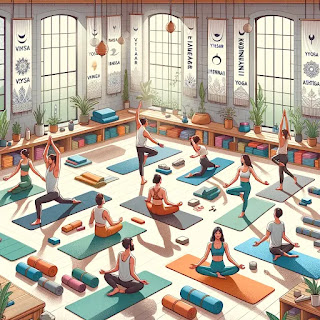
How to Implement and Improve Your Iyengar Practice:
Use Props: Embrace the use of props to explore poses more deeply and safely, enhancing your understanding of alignment.
Slow Down: Give yourself time to adjust and align in each pose. Iyengar is not about speed but depth and precision.
Study the Poses: Delve into the anatomy and purpose of each pose. Understanding the ‘why’ behind a pose can significantly improve your practice.
Kundalini Yoga is a deeply spiritual practice aimed at awakening the Kundalini energy at the base of the spine. This style combines dynamic postures, breathwork, meditation, and the chanting of mantras to cultivate spiritual energy that expands consciousness.
How to Implement and Improve Your Kundalini Practice: Consistent Practice: Regular practice is key to experiencing the profound effects of Kundalini Yoga. Try to incorporate daily sessions, even if brief. Engage in Meditation and Mantra Chanting: Beyond physical postures, dedicate time to meditation and chanting to enhance spiritual awareness and energy flow. Seek Guidance: Due to its intense and spiritual nature, consider working with an experienced Kundalini teacher to safely explore this practice.
Ashtanga Yoga is known for its structured sequence of poses and emphasis on continuous movement. This practice is physically demanding and promotes strength, flexibility, and endurance, as well as a focused and calm mind. How to Implement and
Improve Your Ashtanga Practice: Memorize the Sequence: Familiarity with the sequence allows for a meditative flow, where the mind can focus inward. Practice Regularly: Consistency is crucial in Ashtanga. A daily practice deepens the physical and mental benefits. Be Patient: Progress in Ashtanga is gradual. Respect your body’s limits and celebrate small advancements in your practice.
Exploring these yoga styles can be a journey of discovery and transformation. By understanding the unique aspects of Vinyasa, Iyengar, Kundalini, and Ashtanga, and integrating them into your practice, you can create a personalized yoga experience that nurtures your growth on all levels.
Engaging with the yoga community, whether online or in-person, can enhance your exploration of new styles. Workshops, retreats, and regular classes offer a chance to learn from experienced teachers and connect with fellow yogis. The community provides support, inspiration, and shared experiences, enriching your journey as you explore the vast landscapes of yoga.
As you dive into the exploration of new yoga styles, remember that the journey is deeply personal. It’s about finding your path, embracing the challenges, and enjoying the process of discovery. Let your curiosity lead the way as you deepen your practice and expand your horizons in the beautiful, ever-evolving world of yoga.

Advanced Breathing Techniques:
Ujjayi Pranayama:
Kapalabhati Pranayama:
Anulom Vilom Pranayama:
Bhramari Pranayama:
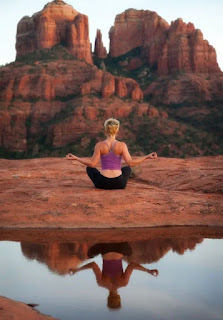
The Importance of Alignment and Form:
Avoiding Injuries In the pursuit of deepening your yoga practice, the significance of alignment and form cannot be overstated. Proper alignment is essential not only for the effectiveness of each pose but also to prevent injuries and ensure a safe and sustainable practice. As you evolve in your yoga journey, understanding and implementing correct form becomes a profound aspect of your growth, enabling you to explore more advanced poses with confidence and grace.
The foundation of any yoga pose involves a stable connection with the ground, whether it’s through your feet, hands, or any other part of the body. Paying attention to this foundation and ensuring it’s strong and stable is crucial for maintaining balance and alignment. Tips for Enhancing Foundation: Spread your fingers or toes wide to increase your base of support. Engage your core muscles to stabilize your posture. Ensure your weight is evenly distributed to avoid undue strain on any one part.
Proper body alignment in yoga involves the strategic placement of every part of your body to achieve the intended posture without causing harm. This alignment is crucial for the energy flow within your body and for engaging the right muscles. Tips for Improving Alignment: Familiarize yourself with the key alignment points of each pose. Use mirrors, feedback from instructors, or video recordings to assess and adjust your alignment. Practice poses slowly to fully understand and feel the correct alignment.
Props such as blocks, straps, and bolsters are not just for beginners; they can be invaluable tools for experienced practitioners to refine their poses, explore deeper stretches, and maintain alignment. How to Use Props Effectively: Use blocks under your hands in standing poses to bring the ground closer if you can’t reach it comfortably. Straps can help in reaching your feet in seated forward bends or maintaining arm distance in poses like the Dancer’s pose. Bolsters can support your back, hips, or legs in restorative poses, allowing for deeper relaxation and alignment.
One of the most important aspects of practicing yoga safely is being attuned to the signals your body sends. Discomfort or pain can indicate misalignment or overexertion. Tips for Body Awareness: If a pose causes pain, gently ease out of it and try a modified version or use props for support. Focus on your breath; if it becomes shallow or strained, it may be a sign to reduce intensity. Remember, each day is different; respect your body’s limits without pushing too hard.
Maintaining proper alignment and form is a lifelong journey in yoga. Regular practice, attending workshops, and learning from experienced teachers can significantly enhance your understanding and execution of poses. Advancing Your Practice Safely: Regularly attend classes or workshops focusing on alignment. Consider private lessons for personalized guidance on your alignment and form. Keep educating yourself through reputable yoga books, videos, and online resources. Incorporating these principles into your practice not only deepens your yoga journey but also ensures it is nourishing and sustainable. Alignment and form are the pillars upon which a fulfilling practice is built, allowing you to explore the vast expanse of yoga safely and profoundly.
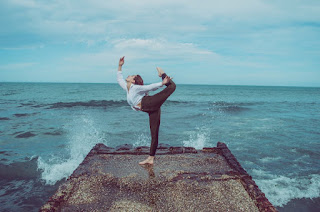
Expanding Your Practice and Community
Practical Tips for Choosing Workshops and Retreats
As you continue to deepen your yoga practice, participating in workshops and retreats can offer profound opportunities for growth, learning, and transformation. These immersive experiences provide a unique setting to explore new dimensions of yoga, connect with like-minded individuals, and dedicate uninterrupted time to your personal development. Here’s how these enriching experiences can elevate your yoga journey.
Workshops are focused sessions that delve into specific aspects of yoga, such as advanced poses, breathing techniques, meditation, and yoga philosophy. They’re often led by experienced instructors who provide detailed instruction, personalized feedback, and insights that can illuminate your practice. Benefits of Attending Workshops: Gain in-depth knowledge of specific yoga elements. Receive personalized guidance and adjustments. Learn new techniques and theories that can revolutionize your practice.
Yoga retreats offer an escape from the hustle and bustle of everyday life, allowing you to immerse yourself in yoga and mindfulness practices. Whether in exotic locations or serene local settings, retreats offer a blend of daily yoga classes, meditation sessions, and the opportunity to connect with nature and like-minded practitioners. Why Retreats are Transformative: Retreats provide an immersive environment dedicated to yoga, facilitating deeper practice and reflection. They offer a chance to disconnect from daily stressors and reconnect with your inner self. Participating in a community of yogis can enhance your sense of connection and belonging.
Both workshops and retreats offer the unique benefit of expanding your yoga community. Engaging with fellow yogis and instructors can inspire and motivate you, offering new perspectives and friendships that enrich your yoga journey. Finding Your Yoga Community: Attend local workshops and retreats to meet practitioners from your area. Join online forums or social media groups related to the workshops and retreats you attend. Stay in touch with instructors and peers for continued support and inspiration.
With countless options available, selecting the right workshops and retreats can be overwhelming. Consider your goals, interests, and level of practice to find experiences that align with your personal journey. Selecting the Right Experience: Research the instructors’ backgrounds and philosophies to ensure they resonate with you. Look for workshops and retreats that focus on areas you’re interested in exploring further. Consider the location, duration, and cost to find options that fit your needs and budget.
The true value of workshops and retreats lies in integrating the insights and practices learned into your daily routine. Reflect on your experiences, journal about your learnings, and consciously incorporate new practices into your yoga and meditation sessions.
Set aside time to practice techniques or poses you learned. Share your experiences and learnings with your yoga community. Reflect on the impact of these experiences on your practice and personal growth. Participating in yoga workshops and retreats can significantly enrich your practice, offering new insights, experiences, and connections that support your journey toward deeper self-discovery and fulfillment in yoga.
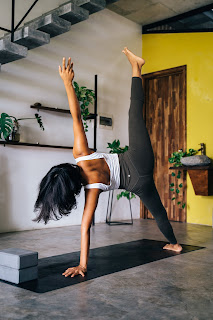
Making the Most of Your Learning:
Embarking on the journey to deepen your yoga practice is a beautiful and transformative process that unfolds uniquely for each individual. From recognizing the signs that signify your readiness to move from beginner to intermediate levels, exploring the rich diversity of yoga styles like Kundalini, Ashtanga, Vinyasa, and Iyengar, to delving into the profound world of advanced breathing techniques, the path of yoga offers endless opportunities for growth, discovery, and self-reflection.
The importance of alignment and form cannot be overstated, serving as the foundation upon which a safe and fulfilling practice is built. By integrating these principles into every pose and sequence, you safeguard your journey, ensuring that each step forward is taken with mindfulness and respect for your body’s wisdom and limitations.
Moreover, the exploration of yoga workshops and retreats opens up new avenues for deepening your practice beyond the mat, offering immersive experiences that enrich your understanding, connect you with a community of like-minded souls, and inspire a renewed commitment to your personal and spiritual development.
As you continue to explore, practice, and evolve within your yoga journey, remember that the essence of yoga is not found in the complexity of the poses you master or the depth of your physical flexibility. It resides in the connection you cultivate with yourself, the peace you find within, and the harmony you create with the world around you. Yoga is a lifelong journey of learning, and each breath, each pose, each moment of stillness is a step closer to your true self. May your practice be a source of strength, joy, and tranquility, guiding you gently towards the infinite potential that lies within. Namaste.
